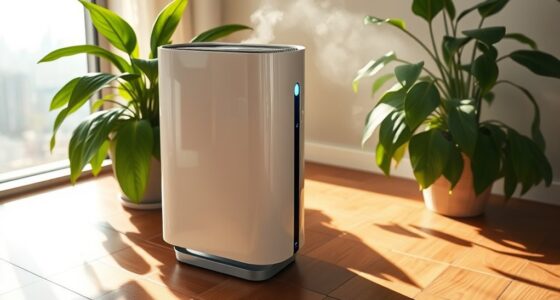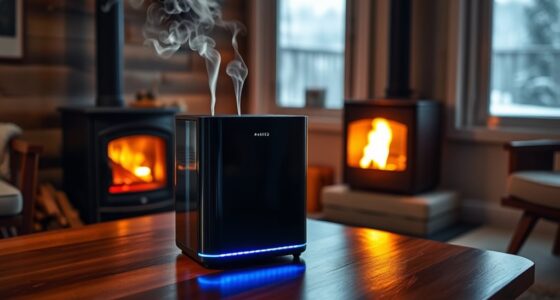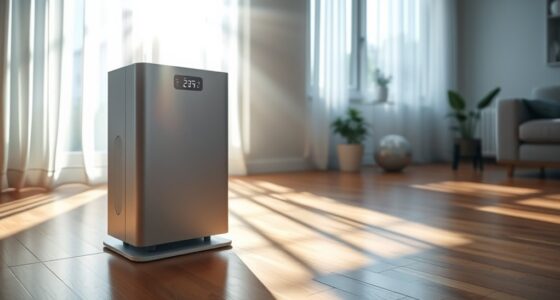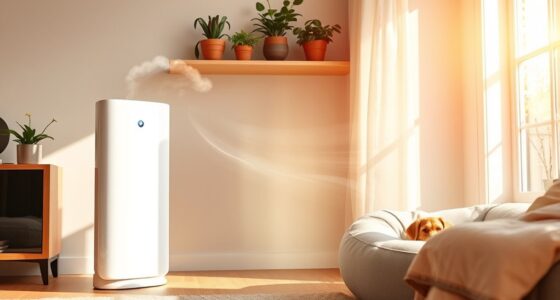Air purifiers are essential during wildfire season because they efficiently filter harmful smoke particles, improving your indoor air quality. Look for models with True HEPA filters that capture up to 99.97% of pollutants, and consider activated carbon filters to eliminate smoke odors. To maximize their efficiency, position your purifier in high-traffic areas and run it on high during smoke events. You’ll also find additional strategies to minimize smoke exposure and keep your home safe from harm.
Key Takeaways
- Air purifiers with True HEPA filters capture up to 99.97% of harmful smoke particles, improving indoor air quality during wildfire season.
- Activated carbon filters in air purifiers eliminate unpleasant smoke odors, enhancing comfort in affected spaces.
- Properly sized air purifiers ensure effective circulation, maximizing smoke removal efficiency in high-traffic areas.
- Regularly replacing filters and running purifiers on high during smoke events maintains optimal performance and health protection.
- Combining air purifiers with strategies like sealing windows can further reduce smoke infiltration and exposure indoors.
What Makes Wildfire Smoke Harmful?
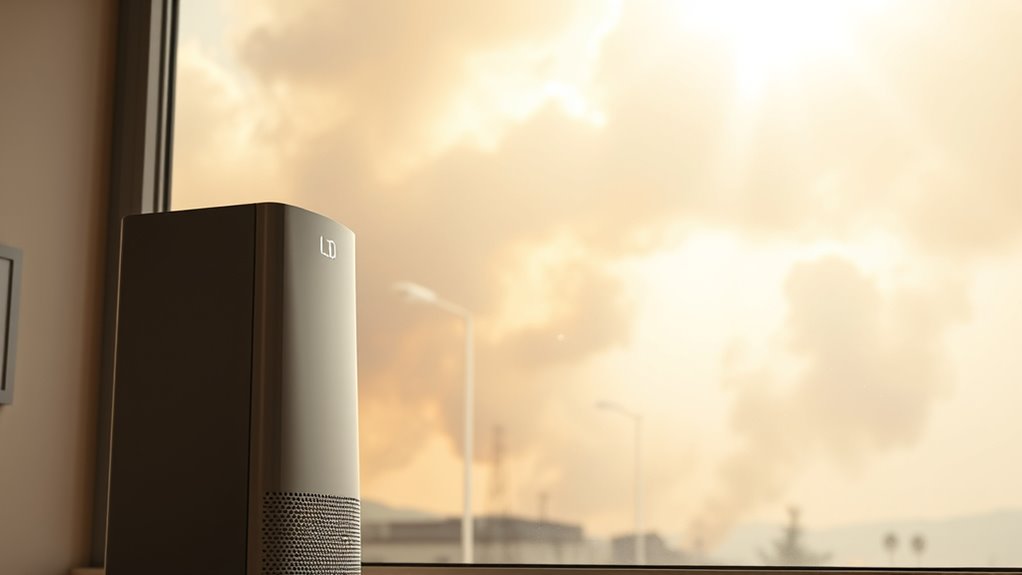
Wildfire smoke is a significant health hazard due to its composition of tiny particles and harmful substances. These particles, often measuring 2.5 microns or smaller, can penetrate deep into your lungs, leading to serious respiratory issues. The smoke contains volatile organic compounds (VOCs), carbon monoxide, and polycyclic aromatic hydrocarbons, all of which contribute to poor air quality. If you’re in an area affected by wildfire smoke, you might experience temporary irritation in your eyes, nose, and throat. Air purifiers equipped with HEPA filter technology are particularly effective in capturing these microscopic particles. Additionally, regular use of air purifiers can lead to improved respiratory health, especially for those living in areas prone to wildfires. Robot vacuums can also assist in maintaining a clean environment by reducing dust and allergens that may exacerbate respiratory issues. Vulnerable populations, like children and the elderly, face heightened risks. Individuals with asthma or heart disease can experience worsened symptoms from inhaling these harmful particles. Using air purifiers can help reduce your exposure and improve indoor air quality during wildfire events, especially when these units are designed for large spaces.
The Effects of Wildfire Smoke on Health

When smoke from wildfires fills the air, it poses serious health risks, particularly for sensitive groups like children and the elderly. This smoke contains harmful fine particles, primarily PM2.5, which can penetrate deep into your lungs, leading to respiratory issues. You might experience eye, nose, and throat irritation, coughing, or worsening asthma symptoms. Utilizing an air purifier with a HEPA filter can effectively reduce these harmful particles in your home. Proper maintenance of your air purifier, including regular filter cleaning and replacement, ensures optimal performance in removing fine particles from the air. Additionally, models with UV light technology can enhance air quality by killing airborne pathogens, providing an extra layer of protection. Studies have shown that mammography guidelines for early detection of breast cancer can also emphasize the importance of monitoring health during environmental crises, especially for vulnerable populations. If you have pre-existing heart or lung conditions, inhaling smoke particles can increase your risk of serious health complications. The Air Quality Index (AQI) rates air quality based on smoke levels; an AQI over 150 is unhealthy for sensitive groups, while over 200 is unhealthy for everyone. Long-term exposure to these particles can lead to chronic health issues, making it vital to monitor air quality during wildfire events. Additionally, maintaining proper air quality through means such as air purifiers can significantly mitigate health risks associated with smoke exposure.
How Air Purifiers Can Help Improve Indoor Air Quality

The dangers posed by wildfire smoke make it essential to guarantee that your indoor air quality remains as clean as possible.
An air purifier equipped with True HEPA filters can capture up to 99.97% of harmful particles, reducing the risks associated with smoke exposure. Furthermore, air quality indicators help you monitor the effectiveness of your purifier in real-time. Regular filter cleaning and replacement are crucial for optimal performance during wildfire season, and following manufacturer guidelines ensures your air purifier operates at its best. Additionally, investing in a reliable home security system can help protect your property from potential threats during emergencies.
Here’s how air purifiers enhance your indoor environment:
- They quickly eliminate fine particulate matter, providing immediate relief during smoky conditions.
- Activated carbon filters help remove unpleasant odors, creating a more pleasant space for you and your family.
- They operate quietly, allowing you to breathe easily while you sleep or relax. Additionally, maintaining good indoor air quality can support gut microbiota and overall health during stressful times like wildfire season.
Choosing the Right Air Purifier for Your Home

Choosing the right air purifier for your home can greatly improve your indoor air quality, especially during times of smoke exposure. Look for a unit with a True-HEPA filter, which captures up to 99.97% of particles, including those in wildfire smoke. Additionally, using a purifier with solar technology integration can enhance energy efficiency while improving air quality. Heat pumps can also be an effective way to maintain a comfortable indoor environment during wildfire season, as they provide both heating and cooling options. Furthermore, utilizing energy-efficient technology in your home can contribute to a healthier living space while minimizing your carbon footprint. It’s important to note that diversifying crypto assets can also help manage risks during market fluctuations, similar to how diversifying air purification methods can enhance indoor air quality.
It’s crucial to select an air purifier sized appropriately for your room to guarantee effective air circulation and clean air. Consider models that feature activated carbon filters to help reduce odors and volatile organic compounds released during wildfires. Additionally, opt for purifiers that operate quietly on lower settings, so you won’t be disturbed at night. Smart features that monitor real-time air quality can also enhance performance, keeping your home safe during wildfire season. Furthermore, understanding the environmental impacts of wood-burning can help you make informed choices about air quality and health during wildfire events.
Tips for Maximizing Air Purifier Efficiency

To maximize your air purifier’s efficiency, it’s essential to place it strategically in your home.
Position it in high-traffic areas or rooms where you spend the most time, ensuring it has the capacity for the space. Avoid corners or behind furniture that can obstruct airflow.
- Choose an air purifier with a True-HEPA filter to effectively capture smoke particles.
- Run it on high for the first hour during wildfire events to quickly clean the air.
- Regularly replace filters, especially after exposure to smoke, to maintain peak performance. Incorporating eco-friendly practices into your air quality management can further enhance your home’s atmosphere during wildfire season.
Additional Strategies to Reduce Smoke Exposure

While using an air purifier greatly enhances your indoor air quality, there are additional strategies that can help further reduce smoke exposure. Start by sealing windows and doors with weather stripping or caulk to keep smoke out. Use your air conditioner to help protect against outdoor pollutants and maintain a clean ventilation system. Limit indoor pollutants by avoiding smoking and using non-toxic cleaning products. Exhaust fans in kitchens and bathrooms can remove indoor contaminants efficiently. Consider adding air-purifying plants like spider plants and peace lilies to naturally improve home air quality. Finally, stay informed by checking local air quality reports to adjust your activities accordingly.
| Strategy | Benefit |
|---|---|
| Seal windows and doors | Prevents smoke infiltration |
| Use air conditioner | Helps protect indoor air |
| Add air-purifying plants | Enhances home air quality |
Importance of Regular Air Quality Monitoring

Regularly monitoring air quality is essential, especially during wildfire season.
With real-time air quality apps, you can track indoor pollution levels and get alerts when conditions worsen.
This information helps you adjust your activities to stay safe and minimize exposure to harmful pollutants.
Tracking Indoor Pollution Levels
How can you guarantee your indoor air quality remains safe during wildfire season? Regular air quality monitoring is essential to track levels of indoor pollution, especially particulate matter like PM2.5 that can creep into your home.
By using air quality monitors, you get real-time insights that help you decide when to activate your air purifiers or keep windows shut.
- Protect your family’s health from harmful pollutants.
- Stay informed and proactive about your living environment.
- Maintain comfort and safety for vulnerable individuals, like children and the elderly.
Understanding metrics like the Air Quality Index (AQI) is significant.
With the right tools, you can effectively manage indoor air quality and minimize the impact of smoke during wildfire season.
Real-Time Air Quality Apps
Are you aware of how essential real-time air quality apps can be during wildfire season? These apps give you instant updates on local air quality levels, tracking harmful particles from the air like PM2.5 and VOCs. They pull data from government sources, alerting you to hazardous conditions. Understanding the air quality index (AQI) helps you determine when it’s unsafe to be outdoors, especially for sensitive groups.
| AQI Range | Air Quality Level | Health Effects |
|---|---|---|
| 0-50 | Good | No health effects |
| 51-100 | Moderate | Some pollutants may be a concern |
| 101+ | Unhealthy | Adverse health effects possible |
Adjusting Activities Accordingly
Monitoring air quality with real-time apps empowers you to adapt your daily activities based on current conditions.
By keeping an eye on the Air Quality Index (AQI), you can make informed decisions that protect your health, especially during wildfire season.
- Limit outdoor exercise when AQI exceeds 150.
- Wear a respirator mask if you must go outside.
- Stay indoors during heavy smoke to minimize exposure.
These adjustments can greatly reduce your risk of respiratory distress linked to wildfire smoke.
Regularly checking air quality updates allows you to identify pollution sources and strategize accordingly, ensuring you stay safe and healthy.
Don’t underestimate the importance of monitoring air quality—your well-being depends on it!
Frequently Asked Questions
Will Air Purifiers Help With Wildfire Smoke?
Yes, air purifiers can help with wildfire smoke. They’re designed to capture tiny particles, including those found in smoke, improving your indoor air quality.
When you use a properly sized unit with a True-HEPA filter, it can effectively filter out harmful pollutants. Just remember to run it continuously during wildfire events and keep up with maintenance, like changing filters, to guarantee it works efficiently.
You’ll breathe easier indoors.
Will an Air Purifier Help With Smoke?
Yes, an air purifier can help with smoke. It’s designed to remove airborne particles, including those from smoke, improving your indoor air quality.
Make certain you choose a model with a True-HEPA filter for the best results. Running it continuously during smoke events guarantees it captures more pollutants.
Also, keep up with regular maintenance and filter changes to maintain its effectiveness. You’ll breathe easier knowing you’ve taken steps to create a safer environment.
Do Air Purifiers Help With Bushfire Smoke?
Yes, air purifiers can help with bushfire smoke.
When you use a purifier equipped with a True-HEPA filter, it captures up to 99.97% of fine particles, including harmful smoke.
Running your air purifier continuously during bushfires guarantees you maintain good air quality.
Make certain to choose a unit that fits your room size, and consider one with activated carbon filters to tackle odors and volatile organic compounds effectively.
What Is the Best Air Purifier for Smoke Fires?
When you’re looking for the best air purifier for smoke fires, focus on models with True-HEPA filters. They efficiently capture small particles, including those found in smoke.
Consider options like the Coway AP-1512HH or Blueair Blue Pure 211i Max, which suit different room sizes. Honeywell purifiers are also excellent, filtering out 99.97% of particles.
Make sure you run your purifier continuously and choose a size appropriate for your space to maximize effectiveness.
Conclusion
As wildfire season approaches, remember that nearly 90% of smoke particles can enter your home, affecting indoor air quality. Using an air purifier can greatly reduce these harmful particles, helping you breathe easier. By choosing the right model and following tips to maximize efficiency, you can create a safer indoor environment. Stay vigilant about air quality, and take proactive steps to protect your health and well-being during these challenging times.


